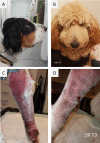Persistent hypercoagulability in dogs envenomated by the European adder (Vipera berus berus)
- PMID: 35180240
- PMCID: PMC8856559
- DOI: 10.1371/journal.pone.0263238
Persistent hypercoagulability in dogs envenomated by the European adder (Vipera berus berus)
Abstract
Background: Envenomation by the European adder, Vipera berus berus (Vbb), is a medical emergency. The overall in vivo haemostatic effects of pro- and anticoagulant components in Vbb venom, and the downstream effects of cellular injury and systemic inflammation, are unclear.
Objectives: To longitudinally describe the global coagulation status of dogs after Vbb envenomation and compare to healthy controls. A secondary aim was to investigate differences between dogs treated with and without antivenom.
Methods: Citrated plasma was collected at presentation, 12 hours (h), 24 h, 36 h and 15 days after bite from 28 dogs envenomated by Vbb, and from 28 healthy controls at a single timepoint. Thrombin generation (initiated with and without exogenous phospholipids and tissue factor), thrombin-antithrombin (TAT)-complexes and the procoagulant activity of phosphatidylserine (PS)-expressing extracellular vesicles (EVs), expressed as PS-equivalents, were measured.
Results: At presentation the envenomated dogs were hypercoagulable compared to controls, measured as increased thrombin generation, TAT-complexes and PS-equivalents. The hypercoagulability decreased gradually but compared to controls thrombin generation and PS-equivalents were still increased at day 15. The discrepancy in peak thrombin between envenomated dogs and controls was greater when the measurement was phospholipid-dependent, indicating that PS-positive EVs contribute to hypercoagulability. Lag time was shorter in non-antivenom treated dogs, compared to antivenom treated dogs <24 h after envenomation.
Conclusions: Hypercoagulability was measured in dogs up to 15 days after Vbb envenomation. Dogs treated with antivenom may be less hypercoagulable than their non-antivenom treated counterparts. Thrombin generation is a promising diagnostic and monitoring tool for Vbb envenomation.
Conflict of interest statement
The authors have declared that no competing interests exist.
Figures


 indicates a significant change between timepoints for envenomated dogs (P < 0.05).
indicates a significant change between timepoints for envenomated dogs (P < 0.05).

 indicates a significant change between timepoints for envenomated dogs (P < 0.05).
indicates a significant change between timepoints for envenomated dogs (P < 0.05).
 indicates a significant change between timepoints for envenomated dogs (P < 0.05).
indicates a significant change between timepoints for envenomated dogs (P < 0.05).References
-
- World Health Organization. Guidelines for the production, control and regulation of snake antivenom immunoglobulins. WHO Expert Committee on Biological Standardization, sixty-seventh report: World Health Organization; 2017. p. 197–388.
-
- Mallow D, Ludwig D, Nilson G. True vipers: natural history and toxinology of Old World vipers. Original ed. Malabar, Fla.: Krieger Pub. Co.; 2003. xiv, 359 p. p.
-
- Hermansen MN, Krug AH, Tjønnfjord E, Brabrand M. Envenomation by the common European adder (Vipera berus): a case series of 219 patients. European journal of emergency medicine: official journal of the European Society for Emergency Medicine. 2018. - PubMed
Publication types
MeSH terms
Substances
LinkOut - more resources
Full Text Sources

